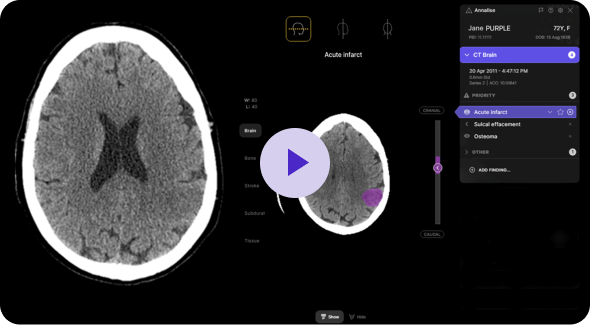
At RSNA we unveiled the latest in our suite of radiology AI portfolio – Annalise Reporting.
Annalise Reporting generates pre-filled, editable draft reports ready for radiologists to review and sign off, fully integrated into the routine radiology reporting workflow.
At a panel discussion moderated by annalise.ai’s Chief Medical Officer Rick Abramson, MD, three experts – Dr Aengus Tran (annalise.ai), Dr Keith Dryer (Mass General Brigham, US) and Dr Geraldine Dean (NHS Epsom St Helier, UK) discussed how reporting represents a crucial step towards greater radiological efficiency while supporting the vital role of radiologists.
Here are 5 key takeaways from the discussion.
1. Comprehensive AI creates comprehensive reports
An automated draft report can only be as good as the solution behind it, and it is essential for a solution to generate reports radiologists are happy to sign off. By nature, narrow AI solutions can only generate narrow reports. This limits reporting scope and is unlikely to enhance efficiency.
In contrast, a comprehensive solution can draft comprehensive reports. Annalise Reporting is built on a foundation of our comprehensive AI models. Many AI vendors are choosing Generative AI and large language model (LLMs) to draft reports. One of the significant challenges of Generative AI is hallucination – a phenomenon wherein an LLM perceives patterns or objects that are non-existent or imperceptible to human observers, creating outputs that are partially or altogether inaccurate.
“The beauty with Annalise’s approach is that we can generate hallucination-free reports because they are grounded in the layers of regulatory-cleared diagnostic findings,” said Dr Aengus Tran, co-founder of annalise.ai.
2. Draft reporting is designed to enhance human/AI collaboration
One question that keeps arising is whether automation will make radiologists redundant. Dr Tran emphasises, “Leveraging AI to draft reports won’t substitute radiologists; on the contrary, it is a contributing factor that will continue to keep radiologists as the owners of the reporting process.”
Annalise Reporting works collaboratively with the radiologist. We have intentionally left the ‘impression’ field blank, for example. “This is one of the most important sentences radiologists write,” Dr Tran said. “It has the power to change patient management and it requires a deep understanding of the patient’s history. So we leave that for radiologists to write, whereas all the routine documentation and image descriptions can be automated away.”
This facilitates a good balance between leveraging the benefits of automation and utilising the clinical skills and judgment of the radiologist.
Soon, Annalise Reporting will also be configured to write structured, semi-structured and narrative reports. It will be enhanced with features that could compare prior and current images and detect technical factors such as position, mobile versus fixed X-ray, and inspiratory status to write draft reports with a high level of sensitivity and specificity.
Greater consistency in format and language has potential to reduce the likelihood of errors in the language and possibly even the report content.
3. Automated draft reporting can enhance efficiency while maintaining quality
annalise.ai has always aimed to scale radiologist’s capacity by improving reporting efficiency. With increased capacity constraints worldwide, AI-supported report drafting could offer game-changing efficiency improvements.
Annalise reporting works by pre-filling study findings into the reporting software so that the radiologist only needs to review them.
Because Annalise Reporting integrates with existing systems, it requires minimal new user interface experience. It can be compared to a semi-autonomous vehicle with features that do not distract you from driving, but rather makes driving easier.
Annalise Reporting may help to reduce reporting turnaround times, decrease workload and administrative burdens, which can be especially valuable in high-volume acute care settings.
4. Automated draft reporting can help solve global radiology challenges
Imaging volumes have continued to escalate post-COVID, with the number of radiologists not able to match demand. Pressure from capacity constraints and workload burdens are driving development of solutions to solve issues such as massive case backlogs.
By saving time and enhancing efficiency, AI-supported draft reporting offers a potential solution to global radiology capacity constraints.
5. Challenges can be seen as opportunities
While there are still challenges around AI adoption, these can be viewed as opportunities for change and innovation.
One example is automation bias. It has been suggested that this human propensity to become over-reliant on automated aids is a potential disadvantage of automated draft reporting. However, Annalise Reporting can be likened to having a registrar or colleague who writes draft reports. As highly skilled specialists, radiologists will not accept a report unquestioningly just because it was drafted for them. They have the clinical responsibility and the final say with edits and completing the impression field.
There exists significant potential for these tools to complement training efforts. One compelling use case involves providing these tools to consultants responsible for reviewing the work of trainees. In this scenario, consultants can compare the work of trainees with automated draft reports to identify any potential errors or omissions, such as overlooked lung nodules or failure to note a mal-positioned nasogastric tube. In this capacity, the tool serves as a safety net for training.
Want to find out more? Book a meeting with our team to see how AI can help your practice.
